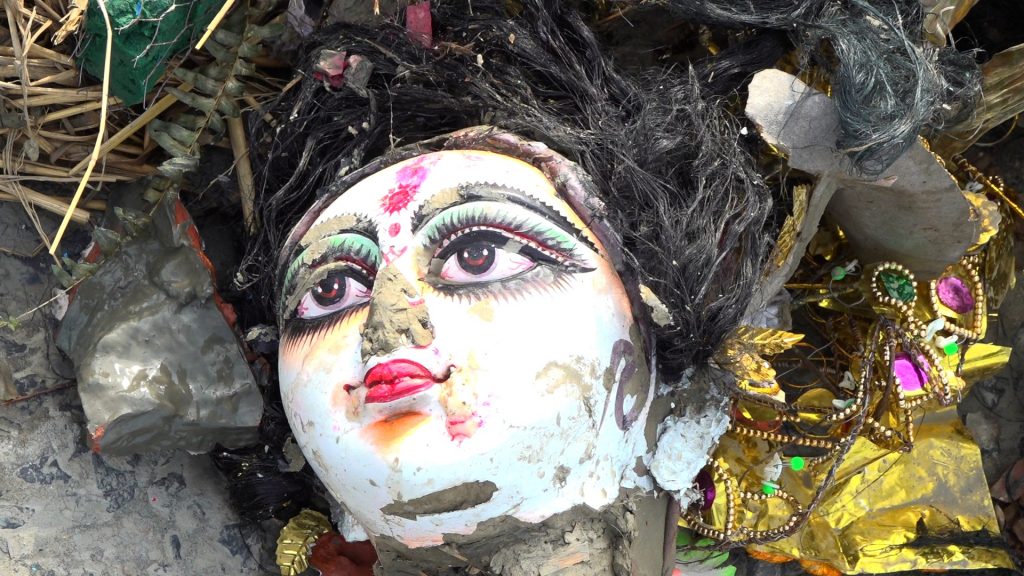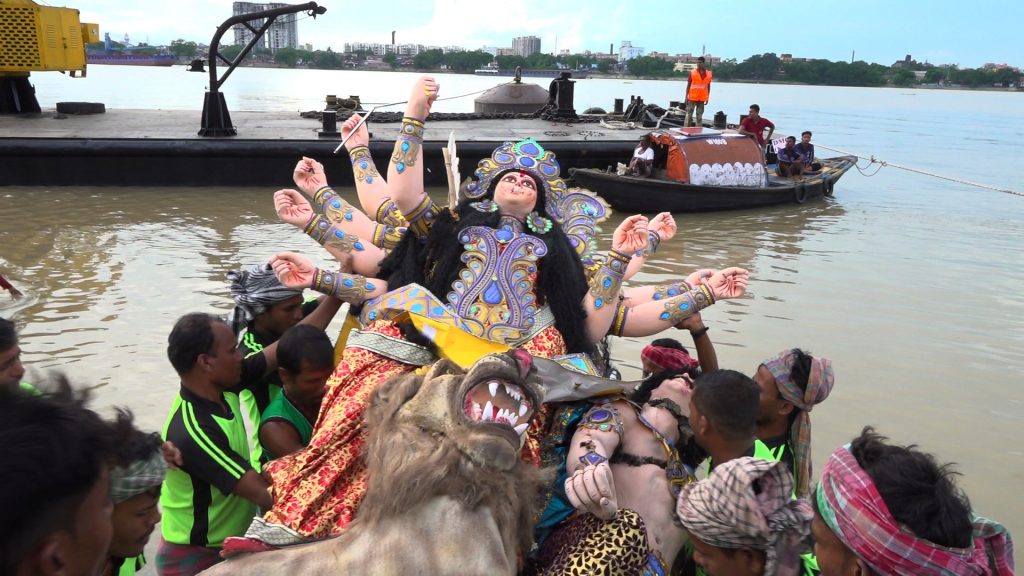Onteshti is a short film by Dhananjay Mandal. It translates as “the last rites” which literally means the rituals performed upon the death of a person. Within its running time of 19 minutes only with the help of visual images and ambient sound, sans dialogue or voice-over draws parallels with the closure of human life upon death and the immersion of the Durga idols on Vijaya Dasami evening.
The last sacrament of the Hindus is Antyeshti or the funeral rites. Like the phenomenon of death, rites and customs connected with the disposal of the dead body are also universal. Man consciously realizes that death is an inevitable end of every human being.

This film has nothing to do with the funeral rites practiced and performed upon the death of a person. It is a metaphor the director draws with the immersion of the idol of Durga with her entire entourage in the waters of the Ganges. This ritual leads to tremendous pollution not only of the water of the Ganges but also of the river banks that are dirtied with the mushy remnants of the idols. Idols that are worshipped with great fervour and dedication for five days in autumn beginning with Shashthi (the sixth day) and ending with Bijoya Dashami.
Says Mandal, “Last rites are also known as onteshti or Antim Sanskar is derived from the Sanskrit word Antya which means last and Isti which means sacrifice, which together means last sacred ceremony. Antim Sanskar is believed to be one of the important Samskaras of the 16 Samskaras in the life of a Hindu. He added, “It is believed that as per Hindu scriptures, the human body and the universe, is made of five elements – air, water, fire, earth and space. The last rites ritual returns the body to these five elements and its origins. This antim sanskar ritual is first identified in the Rig Veda.”

The Kolkata Durga Puja is one the grandest Hindu festivals in India. Collectively, there are about four thousand Durga Pujas in Kolkata every year including the para pujas and the private home pujas. This is scary considering all these idols are immersed in the Ganges after the festival concludes. The ritual of immersion of the idol increases the pollution levels manifold. Hence, over the last few years, the event has been controlled by Govt agencies. This film is about the final journey of Idol immersions at a ghat of the Ganges and what happens thereafter.
The film opens with sounds of the conch shell overlapped with the chants of Chandipath by the late Birendra Krishna Bhadra. The visuals focus on different idols in different pandals with never-ending crowds lined up to offer their prayers and click photos on their smartphones.
This film has nothing to do with the funeral rites practiced and performed upon the death of a person. It is a metaphor the director draws with the immersion of the idol of Durga with her entire entourage in the waters of the Ganges.
From this colourful and grand opening, the scene shifts to one of the many ghats of the Ganges. The music of the conch shell and the voice of Birendra Krishna Bhadra is now replaced with disturbing noise of huge mechanically handled cranes and bulldozers filling the shores of the river picking up the remnants of the idol and depositing them either within the body of the cranes or dashing the wooden structures lifted from the Ganges waters against the walls of the ghats. It offers tragic visuals ending a beautiful festival the entire population of Kolkata and beyond waits for one whole year.
Earlier, immersions on the Ganges ghats were the responsibility of the organizers of the different pujas organising committees. The idol of Durga and her team would be bodily lifted on one, two or three trucks depending on the size of the idols. Then, the truck filled with young groups shouting Durga Mai Ki Jai would take rounds of each neighbourhood before proceeding to the ghats. There, they would get off the truck, light firecrackers, sing songs, dance feverishly to the beats of dhak before immersing the idols in the river. This was a great moment of festivity with sound and colour, song and dance and lots of fireworks dotting the night skies.

But this situation often went out of control as a good number of the participating youth was intoxicated. Besides, ragpickers and street children would step into the river waters to collect much of the discarded remnants such as the jewellery adorning the idols and other trinkets often resulting in drowning accidents.
Today, the situation has been brought under control by Government agencies. Barricades are put up to prevent crowds from entering the immersion banks and waters. The film unfolds with frames showing the idol being thrust into the river waters along with the entire structure that is reduced to wet clay and dirt. Some visuals display the sad sight of the ten hands of Durga covered in mud hanging upside down while being lifted by huge cranes, or, the idol of Saraswati or Ganesha or Kartik floating away sadly in the waters of the Ganges after being pushed into the waters by Government workers in uniforms.
The music of the conch shell and the voice of Birendra Krishna Bhadra is now replaced with disturbing noise of huge mechanically handled cranes and bulldozers filling the shores of the river picking up the remnants of the idol and depositing them either within the body of the cranes or dashing the wooden structures lifted from the Ganges waters against the walls of the ghats.
The air is sometimes dotted with the sound of the dhakis playing on their dhaks while there are also scenes of the Durga idol being carried on the shoulders of workers or on stretcher-like bamboo structures resembling human corpses being carried into the crematorium. Some of these prostate idols are covered with a cloth which makes them appear really like human dead bodies.
When the dhakis are absent, the soundtrack is filled with the loud sounds of bulldozers dashing against the walls with massive structures on which the idols stood to reduce them to debris and silt.
The environmental effects of idol immersion on water bodies and the ecology of surrounding areas are worsening with each passing season – something that believers are either unable to understand or vehemently deny. This pollution, along with industrial waste, accumulates in our water bodies, poisoning our water sources. Fishermen also face problems like dead fish and silt, negatively impacting the quality of the fish they catch. Migrants, who work as rickshaw pullers and porters, use the river’s water for their daily needs. They believe the Ganges is sacred and deny that it can be polluted.
But does controlled and disciplined immersion by uniformed workers hired on contract really reduce the impact on the pollution of the environment? Dhananjay Mandal raises this question through the film but does not offer any answers.
All images were provided by the author.
Shoma A. Chatterji is a freelance journalist, film scholar and author based in Kolkata. She has won the National Award twice, in 1991 and 2000. She has authored 26 published titles of which 14 are on different areas of Indian cinema. She holds two Masters Degrees and a Ph.D. in History (Indian Cinema). She has also won a few Lifetime Achievement Awards from different organizations over time.








